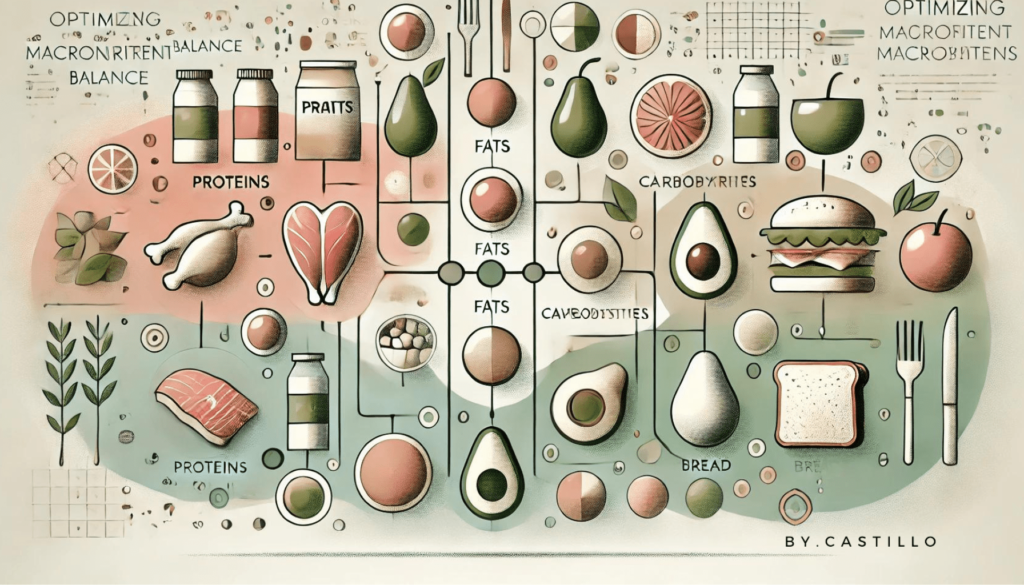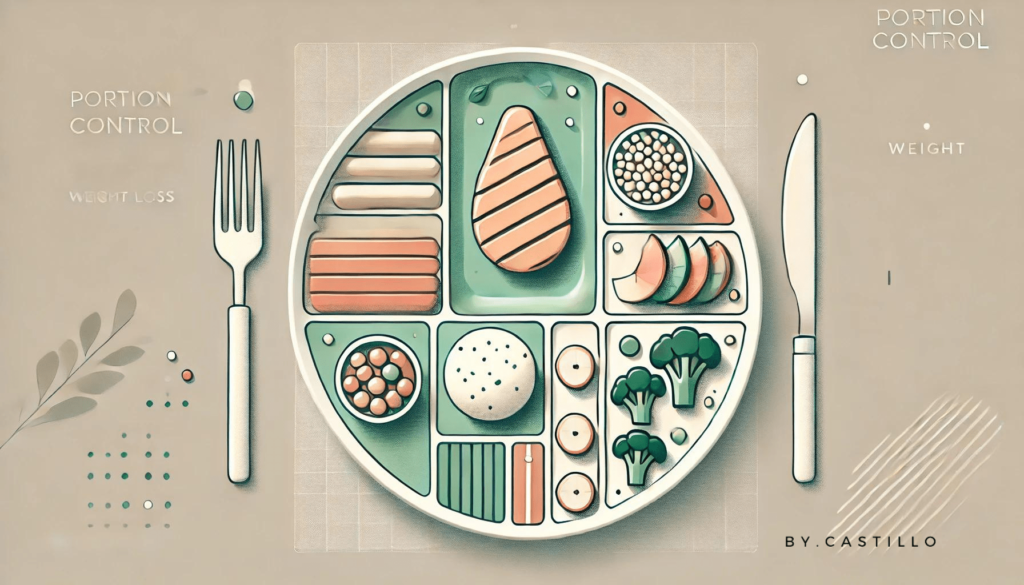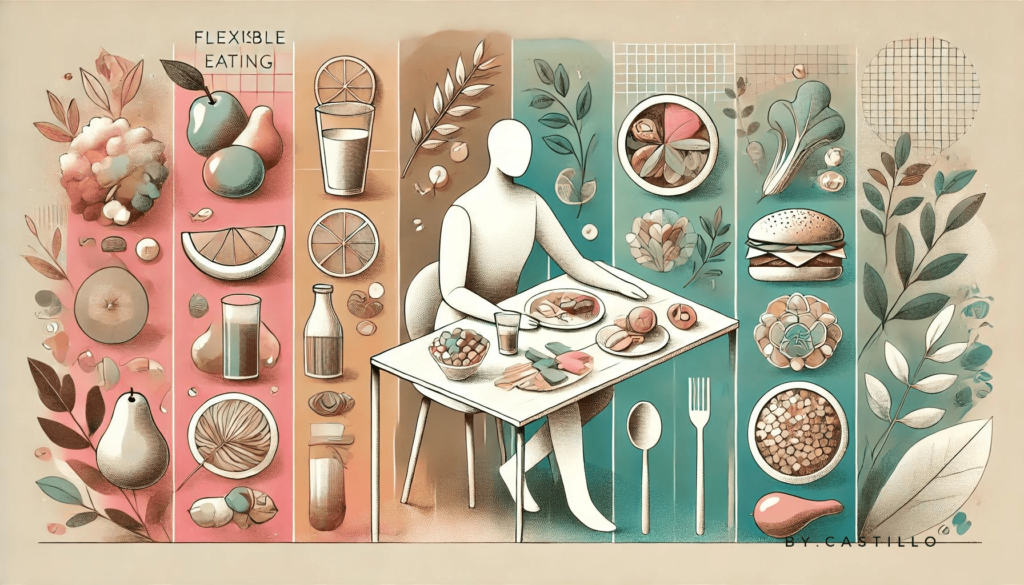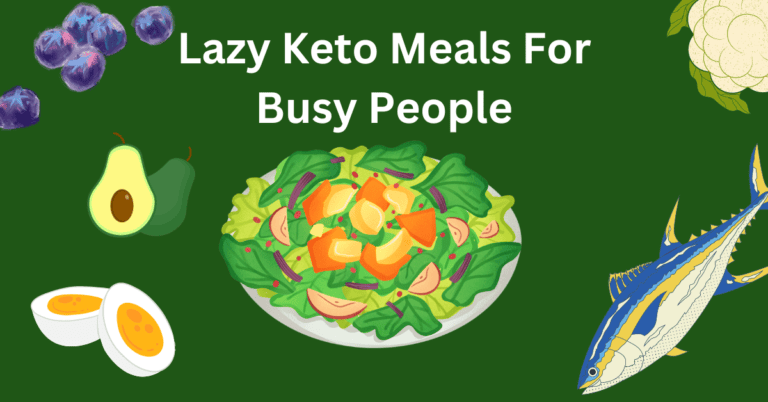Master Sustainable Calorie Deficit: 7 Steps to Sustainable Weight Loss

Are you stuck on a yo-yo dieting rollercoaster? The constant battle of staying in a sustainable calorie deficit can be challenging. But don’t worry you came to the right place! Creating a calorie deficit that can be maintained is like finding the holy grail of weight loss.
Here’s a crazy fact that may blow your mind: 94% of people who successfully lose weight and keep it off have increased their activity level and eaten a lower-calorie diet.
Sounds simple, doesn’t it? Well, not really! The trick is in the “sustainable” part. I’m here to give you the 7 steps to master the perfect calorie deficit and sustain it without losing your mind (or your favorite foods). Let’s get into it!
1. Understanding Calorie Deficit: The Foundation of Weight Loss

Have you ever wondered why some diets succeed while others fail?
It usually comes down to grasping the concept of sustainable calorie deficit.
So what exactly is a calorie deficit, and why is it important for healthy weight loss?
A calorie deficit is when you consume fewer calories than your body burns a day.
When your body doesn’t receive enough calories (energy) from food, it turns to stored body fat for energy, leading to weight loss. This is the fundamental principle of all effect weight loss strategies.
But, not all calorie deficits are the same. Approaching a calorie deficit too aggressively may lead to faster weight regain.
Yes, it may promise quick results but it’s often unsustainable due to aggressive calorie cuts. It will also lead to muscle loss, fatigue, and eventually regaining the weight you lost.
A sustainable calorie deficit promotes gradual, consistent weight loss without sacrificing your health or well-being.
So gradually approaching a calorie deficit will give you the best results and help you create better eating habits.
Let’s bust some common calorie deficit myths:
- Myth: Calorie counting is complicated.
- Truth: With modern calorie-tracking apps and advanced food scales, it’s easier than ever.
- Myth: All calories are equal.
- Truth: The quality of calories matters for overall health and satiety.
- Myth: You need to cut out entire food groups.
- Truth: A balanced approach with nutrient-dense foods is more sustainable and nutritious.
Now that we understand what are calorie deficit is and how it works, let’s look into creating a sustainable calorie deficit.
Let’s dive into the next step.
2. Calculate Your Ideal Calorie Deficit

The first step to a sustainable calorie deficit is figuring out your Total Daily Energy Expenditure (TDEE).
TDEE represents how many calories you burn in a day, factoring in your daily activity level, exercise, and Basal Metabolic Rate (BMR). Let’s go over a few steps on how to calculate this.
Step to Calculate your TDEE:
- Find your BMR: The easiest way is to use TDEE online calculators. This will give you an idea but don’t take it too seriously since these calculators are based on averages. You can also use a Harris-Benedict Calculator to find your BMR. This will give you a foundation to start on.
- Determine Activity Level: Use your best judgment and categorize your activity level as sedentary, lightly active, moderately active, or very active.
- Multiply BMR by Activity Factor:
- Sedentary (little or no exercise): BMR x 1.2
- Lightly active (light exercise/sports 1-3 days/week): BMR x 1.375
- Moderately active (moderate exercise/sports 3-5 days/week): BMR x 1.55
- Very active (hard exercise/sports 6-7 days a week): BMR x 1.725
Following the steps above will give you your TDEE, the total calories you need to maintain your current weight. Now let’s take that information and figure out our daily calorie deficit for weight loss.
Setting a Weight Loss Goal:
- Safe weight loss rate: Aim to lose 0.5 to 2.0 pounds per week. Overshooting this will cause loss of muscle, metabolic slowdown, and potentially fast weight regain.
- Sustainable calorie deficit formula:
- Daily calorie = TDEE – 500-700 calories
- Shooting for a 500-700 calorie deficit will typically result in losing 1-2 pounds per week while balancing fat loss and muscle preservation.
Remember this is about building long-term goals. You shouldn’t be trying to lose 5 pounds every week. A slow, steady weight loss approach is more sustainable and crucial for long-term success.
Now that we know our calorie deficit, let’s talk about macronutrients.
3. Optimize Your Macronutrient Balance

When people think of a calorie deficit, they usually think of eating less but don’t consider the importance of macronutrients.
Ensure that you don’t just focus on quantity but also consider the quality of where you get your calories from is key for healthy weight loss.
Making sure you have a solid macronutrient balance each day will skyrocket your weight loss results.
Let’s look into macronutrients and the role they play.
Importance of Protein for Weight Loss
- Muscle preservation: Protein helps us build and maintain muscle mass during weight loss. It also aids in sustaining your metabolism.
- Satiety: When we eat protein-rich foods it gives us a sense of fullness and satisfaction. The satisfied sense of fullness will also prevent us from overeating.
- Daily Protein Intake: You should aim for 1.0-1.5 grams of protein per pound of body weight. so if you weigh 200 lbs, you should try consuming at least 200 grams of protein daily.
Role of Carbohydrates
- Energy Source: Your body’s main energy source is carbohydrates, especially for physical activity.
- Sustainable Energy Levels: Moderate carbohydrate intake will ensure consistent energy levels and aid in feeling full.
- Focus on complex carbs: Replace refined carbohydrates with complex carbohydrates. Focus on whole grains, fruits, and vegetables, which provide lasting energy and essential nutrients.
Importance of Fats
Hormone Regulation: Healthy fats have a vital role in hormone production, regulation, and is crucial for overall health.
Nutrient Absorption: Fat helps our body absorb fat-soluble vitamin like vitamin A, D, and E.
Sources of Healthy Fat: Avocados, nuts, seeds, olive oil, and coconut oil are all good sources of healthy fats to include into your diet.
Balanced Macronutrient Ratio
A well balanced macronutritent ratio should look something like this:
- Protein: 30-35%
- Carbohydrates: 40-50%
- Fats: 20-30%
So, in other words your diet should consist of 30-35% of your calories from protein, 40-50% should come from your carbohydrates, and 20-30% should come from fats.
Of course, you can change these ratios to your liking but the example above is a well balanced approach. Other diets, like the ketogenic diet, focuses on reducing carbohydrates to 5-10% in order to achieve rapid fat loss.
On another note, it’s also important to consider your body type when adjusting macronutrients. You can read more about body types in our Ultimate Weight Loss Guide to get a better idea of what I mean.
4. Implement Portion Control Strategies

Portion sizes have changed a lot over the years, especially in restaurants. Due to this, keeping calories at a deficit has become more challenging but isn’t impossible. Let’s take a look at a few effective weight-loss strategies to keep your food portions in check:
- Learn to eyeball portion sizes: You can eyeball portions with your hands. Protein portions should be the size of your palm, about 3 oz. Carbohydrate portions should be the size of your fist, about 1 cup. And, a serving size of your thump for fats, about 1 tablespoon of healthy fats.
- Use smaller plates and bowls: This limits the amount of food you can fit into one plate. The tough part? Not going back for seconds!
- Try meal prepping: Meal prepping allows you to control portions in each meal and helps avoid overeating.
- Fill half your plate with vegetables: Vegetables are low in calories but high in nutrients and fiber.
- Food journaling: This helps you become more aware of your eating habits, portion size, and how you feel when you eat certain foods.
Portion control doesn’t mean starving and eating tiny bites of food. Think of it as a way to find the right balance to support your weight loss goals while still enjoying your food.
5. Boost Your Metabolism Through Exercise

Exercise and physical activity are powerful tools in your weight loss arsenal. Not only does it cause you to burn more calories but it also increases your metabolic rate.
This means that it will be easier to maintain a calorie deficit even when you are not exercising.
A Balanced Exercise Routine
To maximize your results and weight loss efforts, your exercise routine should consist of both cardio and strength training.
- Cardio: Cardio exercises like cycling, running, swimming, or even walking are excellent for burning calories and improving cardiovascular health.
- Strength Training: Building muscle with resistance training is vital because muscle tissue burns more calories at rest compared to fat tissue. By increasing your muscle mass, you boost your resting metabolic rate, making it easier to maintain a calorie deficit.
And please, don’t think for a second that you need to get a gym membership because of strength training.
I do encourage it but you don’t need to, if you don’t want to. You can head to your local park and strength train by using your body weight instead of heavy weights in the gym.
Here is a list of body weight exercises you can do at the park, at home, or in your backyard:
- Push-ups
- Squats
- Crunches
- Planks
- Leg-raised
- Lunges
- Pull-ups
- Dip
The key to strength training with bodyweight exercises is time under tension. This means, performing these exercises slowly. This will keep tension in your muscles longer through the range of motion and spark muscle growth. The slower the better!
Increase Your NEAT
Don’t forget about NEAT (Non-exercise Activity Thermogenesis)! NEAT refers to the amount of calories you burn throughout the day based on your everyday activity. This includes walking, standing, running, jumping, etc…
You can make small adjustments in your daily activity routine to increase your NEAT and further boost your daily calorie burn.
Here are a few tips to increase your NEAT:
- Increase your step count: Take the stairs instead of the elevator, and park farther away from the store or your office building. This will increase your daily step count and burn additional calories.
- Stand or walk during calls: Standing or walking while on a call will keep you active. Use phone calls as a cue to move around!
- Use a standing desk: A standing desk encourages movement and reduces sedentary time.
Remember every bit of movement contributes to your calorie deficit. By integrating more physical activity into your daily routines, through structured exercise and incidental movements, you can boost your metabolism and enhance your weight loss progress.
6. Practice Mindful Eating for Better Satiety

Many of us eat without paying full attention to our food, the texture, smell, and taste. We eat so fast that we ignore our body’s signal to stop eating when we get full.
This is where mindful eating comes in for the rescue. Practicing mindful eating helps us manage hunger and controls our appetite, making it easier to maintain a calorie deficit.
What is Mindful Eating?
Mindful eating means savoring each bite of food and paying attention to hunger and fullness cues. It will help you manage your portions and make healthier food choices.
How To Practice Mindful Eating
- Eat without distractions: Put your phone away and turn off the TV. You should be solely focused on your meal. This will help you pay better attention to your hunger and satiety signals.
- Chew slowly and thoroughly: Chewing your food thoroughly will help your body digest it more efficiently and gives your brain time to recognize when you’re full.
- Use all your senses: Make your meal more enjoyable by paying attention to the smell, texture, colors, and flavors of your food.
- Stop eating when you feel 80% full: It takes time for your brain to register fullness, so by stopping before you feel full, you avoid overeating.
Mindful eating can also help with emotional or stress-related eating. Before you go sneak in a snack, stop and think to yourself. Ask yourself these questions:
- Why am I craving food?
- Am I eating out of boredom, stress, or other emotions?
- Am I even hungry or just feel like eating?
Questioning your hunger can help you avoid unnecessary eating and help you stay on track with fewer drawdowns.
7. Implement Flexible Dieting for Long-Term Success

Last but not least, you should implement flexible dieting into your weight loss strategies.
Flexible dieting allows you to enjoy your favorite foods while still maintaining a calorie deficit. As they say “If It Fits Your Macros” (IIFYM).
This approach emphasizes hitting your calorie deficit and macronutrient targets while making weight loss more sustainable.
Flexible Dieting Principles
Flexible dieting is straightforward: as long as you maintain your calorie deficit and macronutrient goals, you can include a variety of food into your diet. This flexible approach makes it easier for you to stick to your calorie deficit while not feeling deprived.
Benefits of Flexible Dieting:
- Reduces feelings of deprivation: Allows you to enjoy your favorite treats and foods, which helps reduce the temptation to binge or abandon your diet altogether.
- Allows for social eating: This one is big! You can enjoy eating at social occasions where you can indulge without feeling guilty.
- Teaches balance and moderation: Promotes a healthy relationship with food and helps you focus on balance rather than strict restriction.
Striking The Right Balance
Although flexible dieting allows you to have treats, your number one priority when losing weight is maintaining a balanced diet.
You can use the 80/20 rule to help you maintain your goals: 80% of the food should be nutrient-dense whole foods, and 20% can be “fun” foods.
This will help you get the necessary nutrients while still enjoying the foods you love.
Additional Considerations For Sustainable Weight Loss
- Water Intake and Weight Loss: Staying hydrated throughout the day boost metabolism, help you stay in a calorie deficit, and helps with appetitie controle.
- Sleep and Weight Management: Getting enough sleep helps regulate hormones and aids in weight manegement.
- Stress Management for Weight Loss: High stress can lead to weight gain, so it’s important to find healthy ways to manage stress like deep-breathing exercises, physical exercise, or meditation.
- Gut Health and Weight: Having a healthy gut microbiome can improve your metabolism and overall health. Try drinking some Kambusha every few days to boost your mircobiome!
- Non-Scale Victories: Don’t just focus on the scale numbers. Pay attention to how much better you feel, the higher energy levels, and your overall well-being.
Flexible dieting helps build a enjoyable and sustainable eating plan and helps build better eating habits for long-term sustainable weight loss.
It’s easy to incorperate into your daily schedule and is very flexible to work with. It a strong weight loss strategy you can start using today!
Wrapping up Our 7 Sustainable Calorie Deficit Steps
Pphheeww! We covered a lot! But there you have it, our 7 steps to maintaining a sustainable calorie deficit.
Remember creating a calorie deficit doesn’t mean saying goodbye to your favorite foods or feeling depleted all the time.
See it as trying to find your sweet spot where you are consitently losing weight but feeling like your on a never ending diet.
Remember, we are not after quick fixes. We want long-term results, and that comes down to building healthy habits that will help us get there and stay there.
Are you ready for this exciting journey to make you healthier and a happier you? Of course you are! So get out there and conquer that calorie deficit because your future self will thank you. Let’s make sustainable weight loss your new superpower!
FAQ’s
What is a calorie deficit, and why is it important for weight loss?
Calorie deficit refers to eating less calories than the number of calories your body requires in order to maintain its current weight. A body in a deficit state has no other option but to use up the stored fat for energy; hence, weight loss. It is the very basis of any plan for losing weight; without it, your body will not burn fat.
How do I create a calorie deficit sustainably?
To create a sustainable calorie deficit, do not reduce your intake drastically all at once; reduce it slowly, by about 300–500 kcal per day. This way, you will not feel excessively hungry or fatigued. Pair it with regular physical activity and prioritize nutrient-dense foods such as fruits, vegetables, lean protein sources, and whole grains in order to remain satiated.
Does a larger calorie deficit lead to faster weight loss?
When thinking of losing weight, a larger calorie deficit might seem like a shortcut to swift reductions, but it is not recommended. Large deficits can cause muscle loss, a slowing of one’s metabolism, and nutrient deficiencies. Plus, it’s harder to stick with. Slow and steady, aiming for 1-2 pounds per week, is more effective and sustainable in the long term.
What happens if I do not eat enough calories?
The body can potentially go into survival mode, thereby slowing your metabolism to conserve energy. This could hamper weight loss and leave you feeling tired, irritable, and more likely to binge. A moderate calorie deficit keeps your metabolism humming and your energy levels stable.






